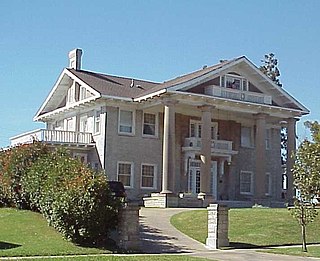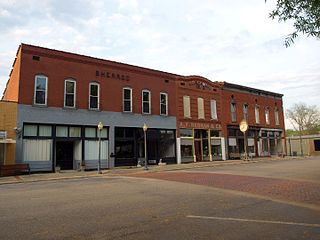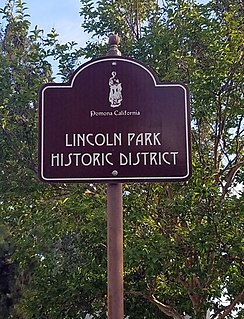
Rittenhouse Square is the name of both a public park and the surrounding neighborhood that is referred to also as Rittenhouse in Center City, Philadelphia, Pennsylvania, United States. The park is one of the five original open-space parks planned by William Penn and his surveyor Thomas Holme during the late 17th century.

Victorian Village is a neighborhood in Columbus, Ohio, United States, north and near west of downtown. It is an established neighborhood built when a streetcar line first ran along Neil Avenue around 1900 with a fair number of established trees for an urban setting. To preserve, protect and enhance the unique architectural and historical features, the Victorian Village Historic District was established in 1973. Columbus Monthly named this neighborhood the top place to live for Arts and Entertainment, with fun right around the corner in the Short North as its neighborhood hangout.

The Hawley–Green Historical District is in the Near Northeast neighborhood of Syracuse, New York. The name comes from the district's two principal streets, Hawley Avenue and Green Street. As Hawley–Green Street Historic District, the district was listed on the National Register of Historic Places in 1979. In 2018 its boundaries were increased to include a number of adjacent streets with similarly styled buildings.

The Morris–Butler House is a Second Empire-style house built about 1864 in the Old Northside Historic District of Indianapolis, Indiana. Restored as a museum home by Indiana Landmarks between 1964 and 1969, the American Civil War-era residence was the non-profit organization's first preservation project. Restoration work retained some of its original architectural features, and the home was furnished in Victorian and Post-Victorian styles. Its use was changed to a venue for Indiana Landmarks programs, special events, and private rentals following a refurbishment in 2013. Regular daily tours of the property have been discontinued.

Brady Heights is a historic district in Tulsa, Oklahoma that was listed on the U.S. National Register of Historic Places in 1980, as Brady Heights Historic District. It was Tulsa's first district to be listed in the Register. According to the NRHP documentation, it is the most complete pre-1920 neighborhood surviving in Tulsa. Its boundaries are Marshall Street to the north, the alley between Cheyenne Avenue and Main Street on the east, Fairview Street on the south, and the Osage Expressway right-of-way on the west. At listing, it included 250 contributing buildings.

The Minne Lusa Residential Historic District is located in North Omaha, Nebraska. It is included on the National Register of Historic Places. According to the National Park Service, it is an "example of a substantial, affordable single-family residential development within the city limits that was platted, developed and constructed by a single firm between 1915 and 1941." The neighborhood is filled with bungalows, Craftsman, and other styles that were popular in the era. There are 540 properties in the neighborhood that contribute to the historic district, the other 167 do not. Minne Lusa Boulevard is a contributing structure.

The Alexander Ramsey House is a historic house museum in Saint Paul, Minnesota, United States; the former residence of Alexander Ramsey, who served as the first governor of Minnesota Territory and the second governor of the state of Minnesota. It was listed on the National Register of Historic Places in 1969. It is also a contributing property to the Irvine Park Historic District.

Elmwood Park is a residential neighborhood and historic district in what is now the center of Columbia, South Carolina. Founded in the early 1900s, it was added to the National Register of Historic Places as Elmwood Park Historic District on May 3, 1991.

The Newtonville Historic District is a historic district in the village of Newtonville, in Newton, Massachusetts. The district encompasses the southern portion of the village's business district, as well as surrounding residential areas. It was listed on the National Register of Historic Places in 1986, and enlarged in 1990.

The Walnut Street Historic District is a national historic district located in Springfield, Missouri, United States. The district encompasses more than 150 one and two story frame, brick, cast-stone, or stone dwellings in a thirteen block area. The district includes parts of East Walnut Street, East Elm Street, East McDaniel Street, Cordova Court, South Hampton Avenue, South Florence Avenue, and South National Avenue. The district developed between about 1870 and 1940, with 21 buildings surviving from before 1900, and 59 buildings dating between 1901 and 1910.

The Charles Nelson Schmick House is located at 110 Walnut Street, Leetonia, Ohio. The three-story, 16-room house contains 5,700 square feet. There are stained glass windows, a wraparound porch, gingerbread detailing and a tower. The house is listed in the National Register of Historic Places.

The Green Street Historic District is a historic district in Marion, Alabama. It is centered on West Green Street and includes examples of American Craftsman, Greek Revival, and Federal style architecture. It contains 33 structures, dating from the mid-1830s to the present, with 24 of them listed as contributing buildings. It was added to the National Register of Historic Places on May 30, 1979.

The Courtland Historic District is a historic district in Courtland, Alabama. Courtland was founded in 1818 and incorporated the following year. Its location was chosen to be close to the Tennessee River to facilitate transportation, but also close to cotton plantations to the south. The town's founders envisioned becoming the county seat of the newly formed Lawrence County, but the title instead went to Moulton. Many of the earliest structures in Courtland were built of logs, and were later replaced with frame and brick buildings. Development plateaued by 1830, but received a slight bump from the Tuscumbia, Courtland and Decatur Railroad beginning in 1834. The oldest houses in the district date from this era, including the 1828 Federal-style John McMahon House and several I-houses.

The Cherry Street Historic District is a historic district in Florence, Alabama. Florence was founded in 1818 and quickly prospered as a cotton shipping port on the Tennessee River, but did not see its greatest growth until the latter part of the 19th century. Spurred by industrial development from several mills and iron furnaces as well as the Florence Wagon Works, the demand for middle-class, suburban homes increased. Five houses in the district date from the late 1800s, but the majority were constructed from the late 1910s through the mid 1930s, when the city saw further growth fueled by the construction of Wilson Dam and a large potassium nitrate production plant. The earliest houses in the district are predominantly Queen Anne style, with late 1800s houses being mostly two stories and early 1900s houses mostly one story. During the second wave of construction between 1920 and 1938, most houses built were bungalows. Five apartment buildings were also built to house the influx of workers coming to the area, centered on North Cherry Street and East Tuscaloosa Street, which became known as "Angel Corner" after its developer, J. M. Angel. The district was listed on the National Register of Historic Places in 1997.

The College Place Historic District is a historic district in Florence, Alabama. The area was the site of a Confederate fortification during the Civil War. In 1882 the land was purchased by Judge J. J. Mitchell and used as pasture land; Mitchell's house sits on Wood Avenue to the east of the district. The property began to be sold off in the 1900s, with the oldest house in the district dating to 1907. Construction in the district accelerated in the mid- to late-1920s, with many professionals including physicians, merchants, scientists, and attorneys building homes in the neighborhood. Styles represented include Mission Revival, Georgian Revival, and bungalows. The district rises on a slight slope above the campus of the University of North Alabama, and has vistas of the campus including Wesleyan Hall. The district was listed on the Alabama Register of Landmarks and Heritage in 1992 and the National Register of Historic Places in 1995; the boundaries were extended in 1998.

The Locust Street Historic District is a historic district in Florence, Alabama. Situated to the northwest of downtown, the residential neighborhood began to develop during Florence's manufacturing-fueled economic boom of the late 1880s. Several large Victorian houses were built in the area around Thimbleton which was built before Tuscaloosa St.. was laid out in the design of Florence by Sannoner. In deference to Thimbleton, Tuscaloosa St. has less width than the other streets. Renowned historical architect, Harvey Jones described Thimbleton as having 3 well done restorations, the original structure being built between 1820-1825 with Federalist Architecture, facing Pine St..The last restoration was late 1800's with French Second Empire Period Architecture, adding 2 rooms, attaching the kitchen, and changing the mansion to face Tuscsloosa St. Other smaller Victorian cottages were also built, many by middle-class residents who moved to Florence looking for work or to take advantage of the city's schools.

The Sannoner Historic District is a historic district in Florence, Alabama. The district lies between downtown Florence and the University of North Alabama and is named for Ferdinand Sannoner, who surveyed the new town in 1818. In the first half of the 19th century, many wealthy merchants, planters, and lawyers built their homes in the neighborhood. Wakefield, believed to be the first brick house in Florence, was built in 1825 in Federal style by an operator of a brick yard. Governors Edward A. O'Neal and Emmet O'Neal, as well as the son of Governor Hugh McVay all made their homes in the district. Emmet O'Neal's house, Courtview, is the centerpiece of the district; the Greek Revival mansion is situated on a hill at the end of Court Street.

The Park-to-Park Residential Historic District in Fort Madison, Iowa, United States, was listed on the National Register of Historic Places in 2014. The historic district is located to the north of the Downtown Commercial Historic District, generally between Central Park on the west and Old Settler's Park on the east. Both parks are contributing sites. For the most part the district is made up of single family homes built in the late 19th and early 20th centuries. Some of these homes were built as rental properties, while others became so in later years. The Albright House and the Chief Justice Joseph M. Beck House are contributing properties, and they are also individually listed on the National Register. There are also duplexes and a few small scale apartment buildings in the district.

The Lincoln Park Historic District in Pomona, California is a 45-block, 230-acre residential neighborhood. The district consists of 821 structures—primarily single family homes built between the 1890's through the 1940's—featuring a wide variety of architectural styles from late Victorian and National Folk homes, Craftsman and Craftsman-influenced homes, and a wide variety of late 19th and 20th Century Revival architectural styles including Colonial, Mission/Spanish, Tudor and Classical Revival.






























